Chapter 23: MULTIPLE CHOICE ANSWERS
Chapter 2: Statement of financial position and income statement
(1) C
(2) C
(3) A
(4) C
(5) C
Chapter 3: Double entry bookkeeping
(6) D
(7) D
(8) C
(9) B
(10) D
(11) C
Chapter 4: Inventory
(12) D
(13) A
(35 × $15) + (30 × $20) = $1,125
(14) C
(15) The correct answer is D
(16) The correct answer is C

Therefore use NRV.
Total inventory figure = $116,400 + $1,000 + $5,500 = $122,900.
Chapter 5: Sales tax
(17) A
(18) B
(19) B
(20) D
Chapter 6: Accruals and prepayments
(21) B
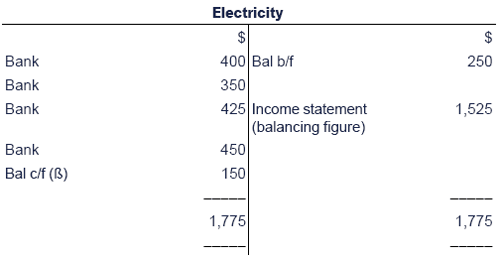
(22) A

(23) B

(24) A
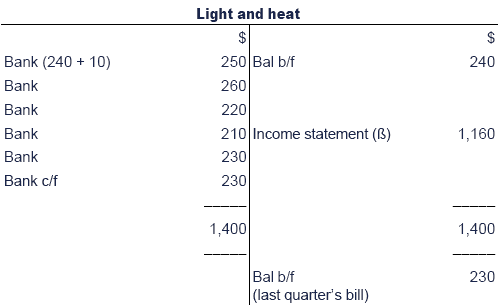
(25) C
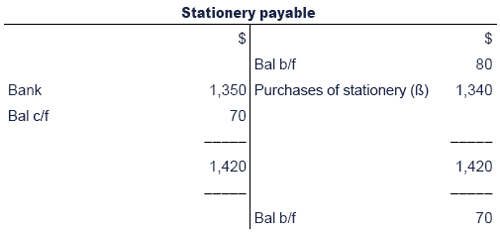
Opening inventory + Purchases – Closing inventory = $165 + $1,340 – $140 = $1,365
Chapter 7: Irrecoverable debts and allowances for receivables
(26) B
5% × (50,000 – 1,000) = $2,450
(27) A

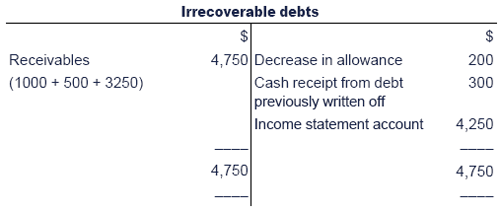

Net receivables = $77,750 – $1,800 = $75,950
(28) B
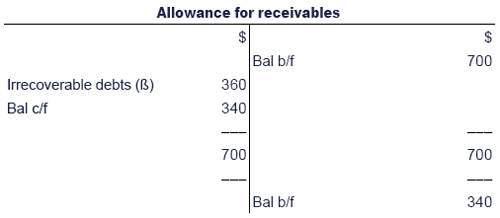
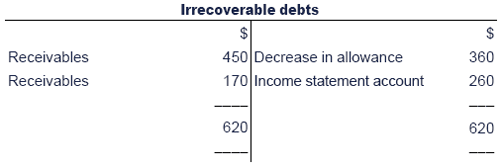
Allowance required at end of year = $700 – $450 – $150 + $240 = $340
(29) B


(30) D

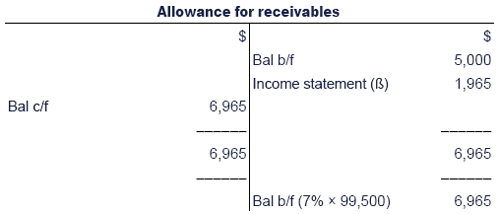
(31) B
This is an example of an irrecoverable debt being writtenoff. Credit the receivables account in order to clear the debt and debitthe irrecoverable debts account with the amount of the debt writtenoff.
(32) A
There is a specific allowance for the debt of $900 which has stillnot been written off as irrecoverable, and an additional allowanceequivalent to 2% of the remaining balance based on past history.
Chapter 8: Non-current assets
(33) B
(34) D
(35) B

Depreciation to disposal
Yr 1: $2,400 × 20% = $480
Yr 2: $(2,400 – 480) × 20% = $384
Yr 3: $(2,400 – 480 – 384) × 20% = $307.20
(36) C
$100,000 + $7,000 + $5,000 = $112,000
(37) B
(38) B
Chapter 9: From trial balance to financial statements
(39) C
Depreciation charge = $11,600 (2% × $580,000)
NBV = $452,400 [$580,000 – ($116,000 + $11,600)]
(40) D
Depreciation charge = $9,375 [25% × $37,500 ($50,000 – $12,500)]
Net book value = $28,125 [$50,000 – ($12,500 + $9,375)]
(41) A
(42) B
Chapter 10: Books of prime entry and control accounts
(43) C
(44) B
(45) A

Chapter 11: Control account reconciliations
(46) A
$8,500 – ($400 × 2) = $7,700
(47) C

(48) B
(49) A
(50) A
The other three lists all contain one item which should appear on the debit side of the account.
Chapter 12: Bank reconciliations
(51) D
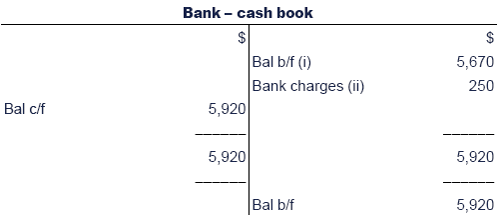
(52) C
(53) B

(54) D
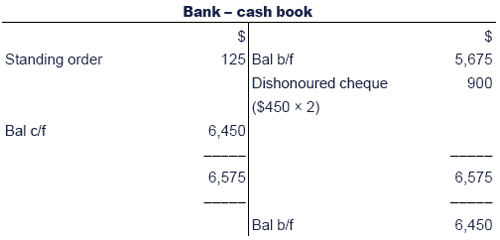
(55) C
The bank reconciliation should have been calculated as follows:
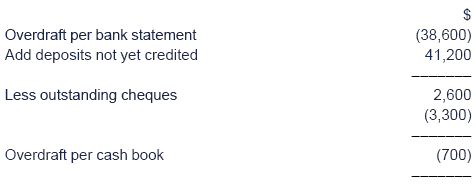
(56) A
Items 3 and 4 relate to timing differences only and would appear in the bank reconciliation.
Chapter 13: Correction of errors and suspense accounts
(57) D
(58) A
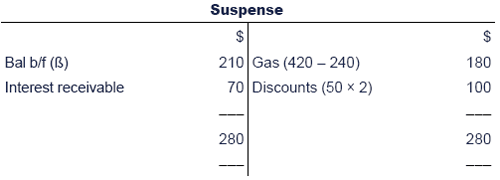
(59) B
(60) C
(61) D
(62) B
The profit will be understated by the following amount:

(63) D
(64) B
Items 1 and 3 would result in an imbalance in the trial balance andtherefore require an entry to the suspense account. Items 2, 4 and 5 donot affect the balancing of the accounts.
Chapter 14: Incomplete records
(65) B
Closing net assets – Opening net assets = Capital Introduced + Profit for year – Drawings
$6,740 – $7,600 = 0 + Profit for year – 1,000
Profit for year = $140
(66) D
Closing net assets – Opening net assets = Capital Introduced + Profit for year – Drawings in year
$27,000 – $10,000 =Capital Introduced + $5,000 – $2,000
Capital Introduced = $14,000
(67) B

15/115 = 13.04%
(68) B
Closing net assets – Opening net assets = Capital Introduced + Profit for year – Drawings
$4,500 – $10,000 = $4,000 + Profit/(loss) – $8,000
Loss for year = $1,500
(69) D

(70) D
Cost of Sales = 75% × $17,000 = $12,750
Purchases = $12,750 + $1,350 – $3,500 = $10,600
(71) A
Credit sales can be calculated as a balancing figure on the Receivables ledger control account.

Credit sales = $412,400, cash sales = $112,900,
Total sales = $525,300
(72) D
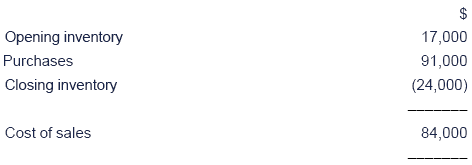
Sales = $84,000 × 100/60 = $140,000
(73) A
The rent expense for the year should be:
(5/12 × $24,000) + (7/12 × $30,000) = $27,500
(74) B
Chapter 15: Company accounts
(75) C
(76) B
(77) B
(78) A
(79) C
Chapter 16: Accounting standards
(80) D
(81) C
(82) C
(83) C
(84) A
(85) C
(86) C
(87) D
Statements 2, 3 and 5 are correct
(88) B
The other lists contain adjusting items
Chapter 17: Statements of cash flow
(89) C
(90) A
(91) B

(92) B
(93) C

Preference dividends 8% × $50,000 = $4,000
Total payments = $12,000 + $4,000 = $16,000
(94) A
(95) B
All other lists contain one or more items that would not appear in the calculation of net cash from operating activities
Chapter 18: Consolidated statement of financial position
(96) A
(97) D
(98) B
(99) C
(100) A
Chapter 19: Consolidated income statement
(101) C
Turnover = X $16 + Y $8 - Intercompany transaction $2 = $22.
y is a subsidiary and Z is an associate. Therefore Z'sturnover will not be included and the inter-company sales with z willnot be eliminated.
(102) C
11 + 10 – 3 (intra group trading) + 1 (PURP) = 19
(103) A
Profit = (600 – 338 – 113 – 38) × 30% = 33,300
(104) B
Profit = (960 – 540 – 180 – 60) × 40% = 72,000
(105) C
Sales $600 – Cost $500 = Profit $100
Half of these goods are in inventory = PURP $100 × ½ = $50 which needs to be added back to cost of sales
(106) A
Subsidiaries are consolidated in full and associates are equity accounted.
(107) B
Chapter 20: Interpretation of financial statements
(108) A
20X6 550 / 2,500 = 22.0%
20X5 360 / 2,000 = 18%
(109) D
20X6 500 / 2,500 = 20%
20X5 500 / 2,000 = 25%
(110) D
Purchases = 3,800 + 32,500 – 6,000 = 30,300
4,750 / 30,300 = 57 days
(111) A
Current ratio
18,940 / 7,221 = 2.62
Quick ratio
5,320 + 10,420 + 3,200 = 13,620 / 7,221 = 1.89
(112) A
146,000 / 24,000 = 6.1 times
Chapter 21: The regulatory and conceptual
(113) D
(114) D
(115) A
(116) A
(117) D
The other three contain items which are not considered to contribute towards reliability.
(118) D
|
Created at 5/24/2012 3:44 PM by System Account
(GMT) Greenwich Mean Time : Dublin, Edinburgh, Lisbon, London
|
Last modified at 5/25/2012 12:53 PM by System Account
(GMT) Greenwich Mean Time : Dublin, Edinburgh, Lisbon, London
|
|
|
|
 |
Rating
:
|
 Ratings & Comments
(Click the stars to rate the page) Ratings & Comments
(Click the stars to rate the page)
|
 |
Tags:
|
|
|
|
|